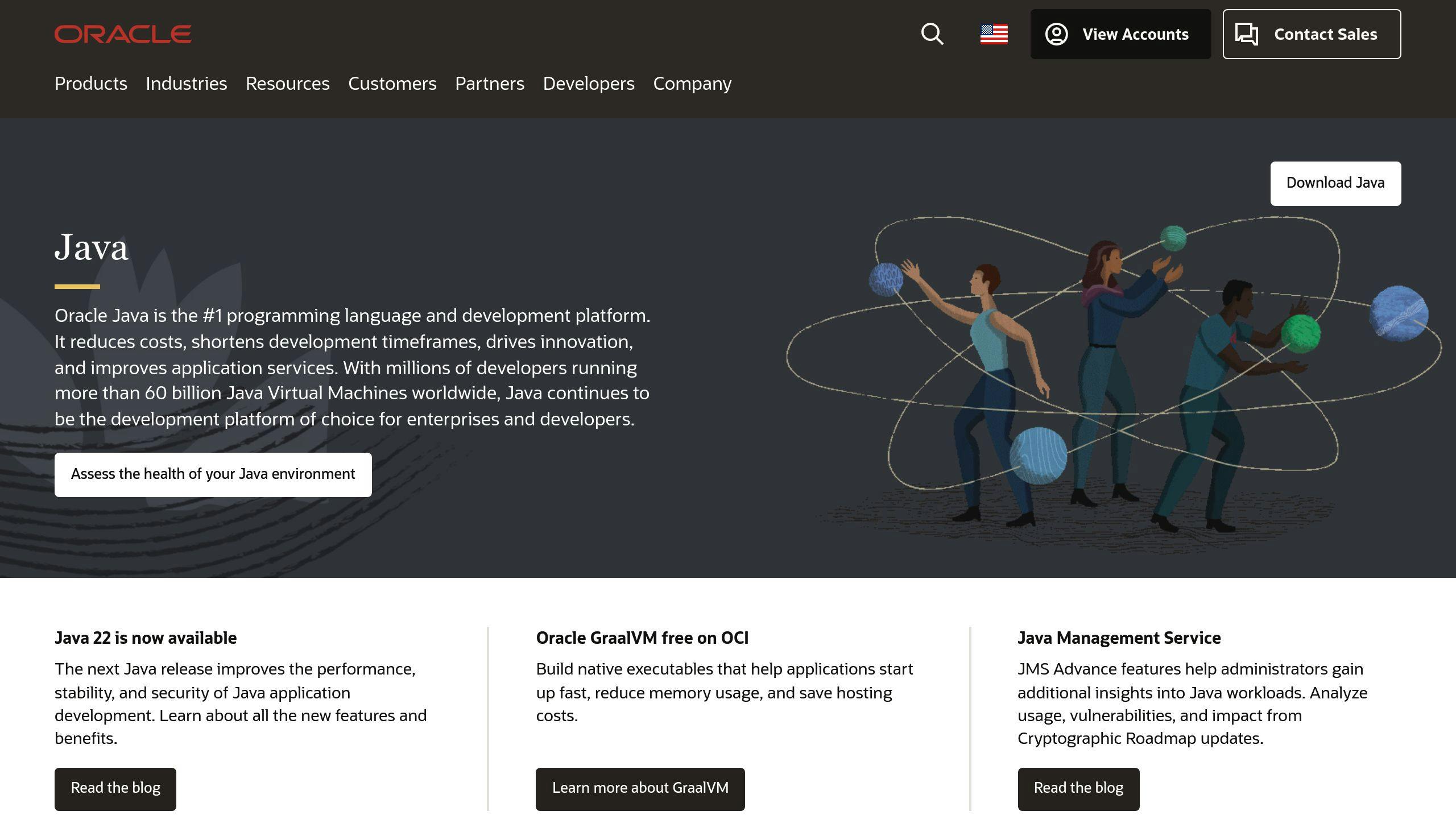Want to stand out as a Java developer? Your portfolio is the key to showcasing your skills and landing better opportunities. Here’s what you’ll learn in this guide:
- Why Portfolios Matter: They demonstrate backend expertise, problem-solving, and code quality.
- What to Include: A professional bio, technical skills, and 3-5 impactful projects.
- How to Present Projects: Use clear descriptions, visuals, and measurable outcomes.
- Boosting Visibility: Optimize your GitHub and LinkedIn profiles to attract recruiters.
- Staying Updated: Regularly add new projects and reflect your evolving skills.
Start building a portfolio that highlights your Java expertise, from Spring Boot to microservices, and ensures you stay ahead in your career.
How to Build a Junior Developer Portfolio That Will Get You Hired
What to Include in a Java Developer Portfolio

Your portfolio should highlight your skills and experience in Java development in a way that grabs the attention of potential employers. Here are the key elements to include to showcase your expertise effectively.
Introduction or About Section
Start with a brief but impactful professional bio that outlines your journey as a Java developer. Focus on your technical strengths and career path, emphasizing areas like enterprise applications or microservices.
Here’s an example of a strong bio:
"Backend developer specializing in scalable enterprise applications with Java and Spring Boot. Passionate about microservices and cloud-native systems, with experience in high-performance financial platforms handling millions of transactions daily."
This introduction sets the stage for the rest of your portfolio by establishing your expertise and focus areas.
Technical Skills Section
After your introduction, organize your technical skills in a clear and structured way. This makes it easy for potential employers to see your strengths at a glance.
| Skill Category | Technologies |
|---|---|
| Core Java | Java 8-17, JUnit, Maven/Gradle |
| Frameworks | Spring Boot, Hibernate, JPA |
| Database | MySQL, PostgreSQL, MongoDB |
| Tools & DevOps | Git, Docker, Jenkins |
| Cloud Platforms | AWS, Azure |
This table format helps to present your skills in a professional and organized way.
Showcase Your Projects
Select 3-5 projects that best demonstrate your Java expertise. For each project, include:
- A brief description of the problem you solved
- Tools and frameworks you used
- Your specific contributions
- Measurable results or outcomes
- A link to the GitHub repository (if available)
Choose projects that highlight a range of skills. For example, you could include a microservices-based application to demonstrate Spring Boot knowledge, a data-heavy project to show database optimization skills, and an API-focused project to highlight your RESTful design abilities. This variety ensures your portfolio appeals to a broad range of potential employers.
How to Present Projects Effectively
Once you’ve chosen your key projects, showcasing them the right way is essential to leave a lasting impression on potential employers.
Writing Clear and Engaging Project Descriptions
Highlight your Java-related skills, such as multithreading, memory management, or API development. Structure each project description around these key elements:
| Component | Description | Example |
|---|---|---|
| Problem Statement | Explain the challenge | "Needed to improve database query performance for a high-traffic e-commerce platform." |
| Technical Solution | Describe your approach | "Implemented database indexing and query optimization using Java 17 and Spring JPA." |
| Impact | Show measurable results | "Reduced average query response time from 2.5s to 0.8s." |
When discussing your technical work, be specific about the tools and versions you used. For instance:
"Built microservices using Java 17, Spring Boot 3.0, Docker, and Apache Kafka to enable real-time data processing."
This level of detail highlights your hands-on experience with modern technologies.
Using Visuals and Supporting Resources
Make your project presentations more engaging by adding visuals:
- Diagrams and performance metrics to explain system designs and improvements
- Screenshots for full-stack or UI-focused projects
- Video demos to showcase complex features in action
Additionally, provide access to:
- Live demos, if available
- Technical documentation
- Video walkthroughs that explain your work step by step
Ensure your documentation is professional, and double-check that all links are functional. Broken links can hurt your credibility.
With your projects effectively presented, the next step is making sure they reach the right audience through smart platform choices.
sbb-itb-f454395
Using Platforms to Increase Portfolio Visibility
Once your projects are well-documented and presented, the next step is to make sure they reach the right audience using the right platforms.
Best Practices for GitHub

Think of your GitHub profile as your technical resume – it shows off your coding skills and how you manage projects. Here’s how to make it shine:
Repository Organization
- Choose clear, descriptive names for your repositories that reflect the project’s purpose.
- Stick to consistent naming conventions across all your projects.
- Use GitHub topics like "java", "spring-boot", or "microservices" to categorize your repositories effectively.
For READMEs, follow the same structure discussed earlier. Make sure each repository includes key details like a project overview, the tech stack used, setup instructions, and architecture details.
Profile Enhancement
- Pin your best Java projects to your profile to make them easy to find.
- Keep your contribution graph active by regularly committing to projects.
- Use a professional profile picture and write a concise, engaging bio.
GitHub highlights your technical skills, but it works even better when paired with LinkedIn to showcase your professional achievements and network.
Improving Your LinkedIn Profile
Did you know that 70% of recruiters look for technical talent on LinkedIn [1]? Stand out by linking your GitHub projects, sharing updates about your work, and participating in Java-related discussions. Add relevant certifications and stay connected with industry professionals by joining and engaging in Java development communities.
Keeping Your Portfolio Updated
An up-to-date portfolio highlights your growth and keeps you competitive in the ever-evolving Java development world. Regular updates reflect your dedication to staying current and improving your expertise.
Adding New Content Regularly
Your portfolio should grow alongside your career. Here’s what to focus on:
Projects and Skills
- Add projects that utilize modern Java features, such as pattern matching or record classes from Java 17.
- Refresh your technical skills section every few months to include new abilities.
- List recent certifications and ensure older ones are still valid.
- Keep project documentation clear and up to date for easy understanding.
Consistent Review Schedule
- Go through and update projects on a monthly basis.
- Reassess your technical skills every quarter.
- Verify and update certifications twice a year.
Staying Current with Industry Trends
The Java ecosystem evolves quickly, and your portfolio should reflect your ability to keep up. Show your familiarity with the latest tools and practices.
Modern Technology Integration
- Highlight projects that use the latest frameworks like Spring Boot 3.0 or Hibernate ORM.
- Include examples of microservices architecture in your work.
- Show your experience with cloud-native tools and development practices.
Professional Development
- Contribute to open-source projects to demonstrate collaboration skills.
- Experiment with new Java technologies to expand your expertise.
- Revise older projects to include features from updated Java versions.
- Engage with Java development communities to stay connected and informed.
"Collaborative or open-source work indicates real-world development experience and is highly valued by recruiters when evaluating Java developer portfolios" [2].
Conclusion: Steps to Build a Strong Portfolio
Focus on Design and Personal Branding
Your portfolio should blend professionalism with a touch of personal identity. A well-organized portfolio reflects the precision and structure valued in Java development. Aim for a clean layout that emphasizes content visibility and smooth navigation.
Visual Hierarchy
- Use clear headings and maintain consistent spacing throughout.
- Stick to a maximum of 2-3 readable fonts for a cohesive look.
- Utilize white space effectively to make content easier to read.
Professional Branding
- Keep your branding consistent with a professional photo, unified color palette, and an optional logo.
- Ensure your contact details are easy to find and prominently displayed.
Summary of Key Points
Once your design is polished, focus on the core elements that make your portfolio stand out. Crafting a portfolio as a Java developer requires thoughtful planning and execution.
Key Portfolio Elements
| Component | Purpose | Key Considerations |
|---|---|---|
| Skills & Projects | Show expertise and capabilities | Highlight diverse projects with clear details |
| GitHub Integration | Showcase your code | Link to well-documented repositories |
| Professional Network | Expand career opportunities | Connect your portfolio to LinkedIn or similar platforms |
Think of your portfolio as a dynamic showcase that grows with your career. Platforms like HackerRank value active GitHub contributions and collaborative projects [2]. Keeping your portfolio updated with both technical achievements and professional progress can help you stand out in the Java development field.
Steps to Get Started:
- Refine Your Content: Make sure project descriptions are clear and impactful.
- Streamline the Structure: Arrange content logically for better navigation.
- Check the Technical Details: Verify that all code samples and projects work as intended.
Your portfolio should highlight not just your past work but also your potential. Focus on showcasing quality over quantity, ensuring every element adds value and demonstrates your Java development skills effectively.
FAQs
How do I build an effective Java developer portfolio?
A solid Java developer portfolio highlights your ability to solve problems and showcases your technical skills. In fact, 65% of recruiters prioritize problem-solving skills demonstrated through portfolio projects [2].
What to Include:
- A brief introduction to your Java experience
- A section for technical skills, grouped by categories
- A project showcase featuring practical, real-world applications
Choosing the Right Projects:
| Project Type | Why It Matters |
|---|---|
| API Development | Highlights backend and system design skills |
| Full-stack Applications | Shows your ability to handle front-end and back-end development |
| Open Source Work | Demonstrates teamwork and collaboration |
Where and How to Present: Platforms like GitHub or GitLab are great for displaying your work. Notably, 60% of hiring managers prefer portfolios that feature collaborative projects [2].
Tips for Success:
- Include clear documentation and, if possible, live demos
- Regularly update your portfolio to reflect your current skills
- Remove outdated projects that no longer represent your expertise
- Keep documentation consistent and easy to follow
Focus on quality over quantity. Highlight projects that solve real problems or automate tasks using Java. A well-structured portfolio with diverse, well-documented projects can help you stand out in the competitive world of Java development.





